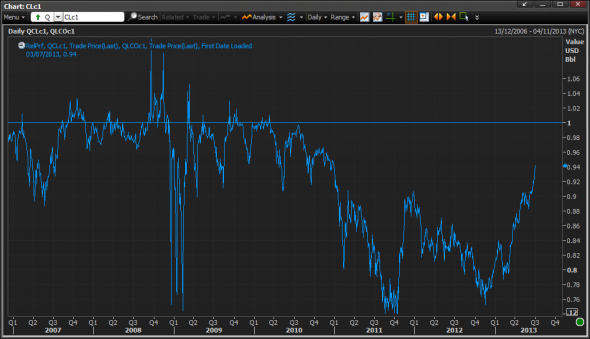I went with the Egypt angle by using ZeroHedge's Tuesday headline "Crude Surges Past $100 As Cairo Death Toll Rises" but I didn't do it so much for the oil price thing as for a pivot to question why the hell the U.S. is backing the restore the Caliphate crowd in Egypt and the al Queda boys in Syria..
For some reason ZeroHedge is still making the simplistic "It's the WOGS eh wot" pitch:
...After a few hours of calm yesterday, crude oil prices are once again surging back over $102 as the commander of the Third Field Army stated that troops deployed in Suez and South Sinai saw their "state of readiness" raised to "Maximum Alert." The announcement came after Cairo's airspace was closed for 40 minutes and flights were diverted to other airports because of air force drills. The 'state of emergency' has sent stocks sliding and put a modest bid into precious metals amid a call by Islamist allies of ousted Egyptian Prwsident Morsi to "take to the streets" and express their outrage....Here to school the ZH boys is Izabella d'Alphaville who wrote this piece a few hours before the military stepped in:
WTI and the taper effect
Lots of commentary is linking the mini-surge in WTI overnight, and subsequent WTI-Brent compression, to events in Egypt.
But it’s probably much more related to a shift in interest-rate expectations than anything to do with Middle Eastern tensions.
First of all, here’s what the compression looks like on a longer timeframe:
It’s clear from the chart that the spread first began tightening in earnest in the fourth quarter of 2011. In fact, at the time, many market participants positioned themselves pretty heavily on the expectation that the spread would continue to tighten because the Seaway pipeline was set to be reversed.
But the tightening turned back into unexpected widening, and before we knew it many funds and market participants found themselves nursing heavy losses related to the WTI-Brent spread.
Everyone blamed Iran for the anomaly.
Interestingly enough, the latest round of spread tightening began in the fourth quarter of 2012, and was not related to any obvious infrastructure news. Though it did coincide with the first talk of Abenomics.
As for what has taken it through the latest resistance level… that move certainly coincides with the march of real rates higher (as fuelled by falling CPI, rather than rising interest rates)....MORECombined with "Scarcity amid plenty – Part Deux" which was posted a few hours later and you have a truer picture of recent oil market dynamics than you are likely to find outside of Vitol or Trafigura headquarters:
A while back we talked about the anomaly of backwardated curves amid a veritable abundance of US and global inventory.
Or more specifically, the irony that prices were falling even as curves were implying backwardation (usually a bullish signal reflective of tight supply).
As Robert Campbell of Reuters asked at the time:
Why was the futures market signaling to holders of inventory to sell stocks at precisely the moment when they were building stocks?We put this down to artificial scarcity measures, focused on the Brent market, which had the ability to keep prices supported in a specific grade like Brent even as spare capacity and inventory was rising in the wider market.
We also argued that this was being exacerbated by the fact that warehoused crude was staying warehoused for longer than usual because the US contango was providing a wonderfully appetising return on capital, relative to what could be achieved in conventional money markets....MUCH MORE
